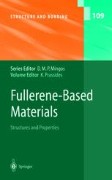Search
Search Results
-
Structural Aspects of Layered Double Hydroxides
Layered double hydroxides (LDHs) have been known for a considerable time and have been widely studied. The basic features of their structure,...
-
n-Body Decomposition Approach to the Calculation of Interaction Energies of Water Clusters
A new methodology is proposed in which large basis set MP2-level calculations can be extended to water clusters with as many as 50 monomers. The...
-
Multiporphyrin ArraysAssembled Through Hydrogen Bonding
Although relatively weak in isolation, composite H-bonds can be used as an advantage for the assembly of relatively robust and well-defined arrays...
-
Axial Coordination to Metalloporphyrins Leading to Multinuclear Assemblies
The use of axial coordination to metalloporphyrins is discussed on the basis of constructing multinuclear complexes. Starting with single...
-
Intermolecular Interactions via Perturbation Theory: From Diatoms to Biomolecules
This article is devoted to the most recent, i.e. taking place within the last few years, theoretical developments in the field of intermolecular...
-
Development of Technetium-99m and Rhenium-188 Radiopharmaceuticals Containing a Terminal Metal–Nitrido Multiple Bond for Diagnosis and Therapy
The chemistry of nitrido complexes of technetium has played an important role in the search of new Tc-99m radiopharmaceuticals and in providing...
-
Liquid Chromatography under Critical and Limiting Conditions: A Survey of Experimental Systems for Synthetic Polymers
At the interface between the entropic size exclusion separation and the enthalpydominated liquid adsorption chromatography it is possible,...
-
Laser Application of Polymers
Laser ablation of polymers has been studied with designed materials to evaluate the mechanism of ablation and the role of photochemically active...
-

-
Spin Crossover in Iron(II) Tris(diimine) and Bis(terimine) Systems
Tris(diimine) and bis(terimine) iron(II) complex salts constitute one of the major classes of spin crossover systems. Both electronic and structural...
-
Surface Modification of Polyethylene
Polyolefins such as polyethylene, polypropylene and their copolymers have excellent bulk physical/chemical properties, are...
-
Probing Hydrogen Bonding in Solids Using Solid State NMR Spectroscopy
Solid state nuclear magnetic resonance (NMR) spectroscopy is a powerful and versatile technique for probing structural and dynamic properties of...
-
Determination of the absolute fringe number in Rayleigh interference patterns in systems at sedimentation equilibrium via a newly defined function (kΔ)
Analysis of data from the analytical ultracentrifuge used in sedimentation equilibrium modes calls for knowledge of the absolute (as distinct from...
-
Determination of very broad particle size distributions via interference optics in the analytical ultracentrifuge
Dispersions play a big role in industry. Important characteristics such as viscosity and gloss depend on the particle size and the particle size...
-

-
Effects of acetylation on thermodynamic properties of seaweed alginate in sodium chloride solutions
Alginates are polysaccharides consisting of mannuronate and guluronate units. While bacterial alginate is acetylated, seaweed alginate does not...
-
Structural and Electronic Properties of Selected Fulleride Salts
The study of strongly correlated electron systems is at the forefront of contemporary condensed matter research because such materials, which include...
-
Ligand-Driven Light-Induced Spin Change (LD-LISC): A Promising Photomagnetic Effect
“Ligand-driven light-induced spin change” (LD-LISC) is a photomagnetic effect based on the modulation of the ligand-field strength of a suitable...
-
Valence Tautomeric Transition Metal Complexes
Valence d-orbital energies of the first row transition metals are close to the frontier π-orbital energies of o-benzoquinones. Complexes prepared...
-
Structural Aspects of Spin Crossover. Example of the [FeIILn(NCS)2] Complexes
The interplay between the spin crossover and the structural properties of the complexes in the solid state is still under investigation. In...
